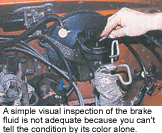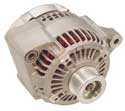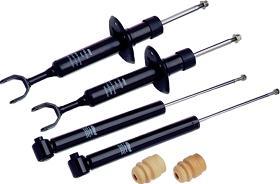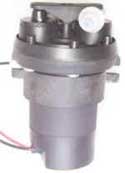Brake Fluid Does Wear Out
What is the service life of brake fluid? That is a question for which there is no simple answer. But it doesn't last forever.
Most motorists don't know that brake fluid wears out over time. They assume it is a lifetime fluid that never needs to be changed, so brake fluid is probably the most neglected fluid in vehicles today.
As brake fluid ages, the corrosion-inhibiting additives in it break down. The earliest signs of chemical decomposition can often be detected within a year or so, or after 10,000 to 12,000 miles of normal driving. Hard use that elevates brake temperatures and pressures can accelerate the rate at which the fluid additives break down even more.

As time goes on, heat and chemical activity continue to erode the fluid's ability to prevent corrosion. Oxidation starts to eat away at metal surfaces creating dissolved acids and sludge that are carried with the fluid as it surges back and forth with every application of the brakes. Some of these contaminants are abrasive and increase seal, piston and bore wear in the calipers, wheel cylinders and master cylinder. As the fluid gets dirtier and dirtier, it accelerates mechanical wear in the brake system. If not corrected, it may cause some components to fail prematurely. ABS solenoid valves, in particular, are sensitive to this type of attack - and can be very expensive to replace.
Moisture also creeps into the system to further add to the contamination problem. Humidity in the air can be drawn into the fluid anytime the fluid reservoir is opened for inspection or anytime a brake hose, line or bleeder valve is opened when servicing the brakes. Even if the fluid reservoir is never opened, moisture will still infiltrate the system through microscopic pores in rubber brake hose. The rate at which this happens depends on the age of the vehicle and the type of brake hose used. Newer hose made with linings that are less permeable to moisture help extend the life of the fluid. Even so, moisture can still slip past piston seals in wheel cylinders and calipers.
FLUID FACTS
To understand why moisture enters the brake system,
you need to know something about the chemistry of brake fluid.
Glycol-based DOT 3 and DOT 4 brake fluids are both "hygroscopic," which
means they attract water. Leave a bottle of brake fluid open for several
days and it will pull moisture out of the air like a magnet. This is one
reason why vehicle manufacturers use glycol-based brake fluid: it
disperses moisture that enters the system throughout the fluid to dilute
the contamination. This prevents moisture from forming puddles in calipers
or wheel cylinders that could boil and cause pedal fade if the brakes get
too hot. The downside is that moisture lowers the boiling temperature of
the fluid, increases its viscosity and promotes internal corrosion. That's
why various chemical additives are put into the fluid to help it fight
corrosion and oxidation.
All brake fluid must meet minimum performance standards established by the U.S. Department of Transportation (DOT). Most brake fluids usually surpass these standards, but it's important to know what the minimums are because of their potential impact on driving safety.
For all fluids that meet the DOT 3 specification, the minimum "dry" (contains no water) boiling temperature is 401° F and the minimum "wet" (saturated with water) boiling temperature is 284° F.
For all fluids that meet the DOT 4 specification, the minimum dry boiling temperature is 446° F and the wet boiling temperature is 311° F.

How do these numbers compare with most new brake fluids? For many years, Ford has used a special "high temperature" DOT 3 fluid with a dry boiling temperature of 580° F. General Motors, Chrysler and most "heavy-duty" aftermarket fluids typically have a dry boiling temperature of at least 475° F and some go as high as 550° F. By comparison, most DOT 4 fluids start out with a dry boiling temperature of 509° F or higher.
As you can see, most new fluids far surpass the minimum standards required by the DOT. This provides an extra margin of safety to minimize the risk of fluid boil and pedal fade in severe braking situations when the brakes get really hot. But, moisture contamination can quickly reduce the margin of safety.
According to some studies that have been done, brake fluid typically absorbs about one percent or more moisture per year of service life. Many two-year-old vehicles have as much as two to three percent water in the brake fluid. Imagine how much water must be in some vehicles that are six, eight or 10 years old and have never had the fluid changed!
As the fluid becomes contaminated with moisture, its boiling temperature drops. Only one percent moisture can lower the boiling point of some DOT 3 fluids down to 369° F. Two percent water can push the boiling point down to 320° F, and three percent can drag it all the way down to 293° F - which is getting dangerously close to the minimum DOT requirements.
Why don't the vehicle manufacturers simply switch to DOT 5 brake fluid that is silicone-based and repels moisture? One reason is that silicone brake fluid is very expensive compared to glycol-based fluids. Another is that silicone fluid contains more dissolved air and aerates more easily when pumped rapidly through small orifices that can increase pedal travel and reduce pedal firmness (a spongy pedal). Because of this, most vehicle manufacturers warn against using DOT 5 brake fluid in any vehicle equipped with ABS.
DOT 5 also cannot disperse moisture that enters the system throughout the fluid like DOT 3 and DOT 4 fluids. Any water that does get inside tends to "slug" and settle to the lowest point in the system, which is usually the calipers and wheel cylinders. Slugs of pure water are not something you want inside a brake system because they concentrate corrosion and increase the risk of pedal fade if the water gets hot enough to boil (it only takes 212° F to turn liquid water into steam).
Where DOT 5 fluid works best is in vehicles that sit for long periods of time (antique and classic vehicles that are stored during winter months or in a museum), or in vehicles that are operated in extremely wet environments (including off-road).
The best advice is to always follow the vehicle manufacturer's recommendations as to which type of brake fluid to use. For most vehicles, that's going to be DOT 3 or DOT 4 brake fluids.
FLUID CHECKS
There are a variety of ways to check the condition
of the brake fluid. A simple visual inspection is not adequate because you
can't tell the condition of the fluid by its color alone. Some new fluids
are almost clear while others are yellow. A darkish appearance doesn't
necessarily mean the fluid is bad, but if you see visible sediment in the
master cylinder fluid reservoir, the fluid is obviously long overdue for a
change.
In one test, brake fluid samples were collected from 86 vehicles. The fluid ranged in color from light amber to dark murky brown. Testing revealed that the moisture content of the light amber fluid samples (which most technicians would probably say looked OK) contained as much moisture (1.1 to 4.5%) as many of the darker samples (which ranged from 0.9 to 7.0% moisture content). In fact, there were some darker-looking samples that actually contained less moisture than the lighter color samples. The conclusion? There's no correlation between the color of brake fluid and its water content.
To determine the fluid's condition, you have to test it chemically, physically or electronically.
One such method is to use chemical test strips that react to ions produced by the breakdown of corrosion-inhibiting chemicals in the fluid. These test strips are relatively inexpensive (less than 50 cents apiece), easy-to-use and can detect fluid breakdown in its earliest stages. The strips are color coded with a scale of 0 to 100 so you can judge for yourself the condition of the fluid.
When this test method was used to check a fleet of 50 vehicles, 86 percent of the vehicles more than two years old showed dangerously low levels of corrosion inhibitor in the brake fluid - which is why many experts recommend replacing the fluid every two years for preventive maintenance.
According to one supplier of the ion detecting strips, "probably 80 percent of the vehicles coming through a typical aftermarket brake shop will fail this kind of fluid test." Why? Because most have never had the fluid changed - even if the brakes have been serviced before.
Unless hydraulic components are being replaced (calipers, wheel cylinders, brake hose, etc.), some shops won't take the time to flush out the lines and replace the old brake fluid with new. They may top off the fluid reservoir, but that's all. Others may not even take the time to properly bleed the brakes for fear of breaking off a bleeder screw.
According to a recent survey of BRAKE & FRONT END readers, brake fluid is flushed and replaced only 40 percent of the time when doing a normal brake job - and less than 15 percent of our readers say they routinely flush the fluid on every brake job!
At the very least, all lines should always be bled to get rid of any trapped air, and ideally every brake job should include a complete fluid flush and change to get rid of contaminants and restore the fluid to like-new condition.
There are also chemical test strips that react to the presence of water in the fluid. This type of test strip changes color to indicate the degree of contamination. If the fluid contains two to three percent water, it is considered "borderline." Three percent or more water calls for a fluid change.
Another method of checking brake fluid is to determine its moisture content and boiling temperature using a tool called a "refractometer." This is a precision optical instrument that uses the fluid's "refractive index" to reveal its condition. Moisture alters the way the fluid bends light, making it easy to see the amount of contamination on a scale in the eye piece. To check the fluid, all you do is put a couple drops of fluid from the master cylinder on the instrument's prism, lower the sample cover and look through the eyepiece. The refractometer scale is calibrated for standard DOT 3 brake fluid and high temperature or racing DOT 3 fluid, so a second refractometer is required to read DOT 4 fluids. Unfortunately, refractometers are fairly expensive costing upwards of $300 apiece. Even so, they can quickly pay for themselves if used effectively to sell the need for fluid changes.
Another way to check brake fluid is to use an electronic tester. Some measure the electrical resistance of the fluid while others measure the fluid's actual boiling temperature. The latter will usually give more accurate results than resistance testers because you get a real number. Some new fluids can test badly with resistance-style testers because of additives in the fluid. Testing typically takes about 30 seconds with a tester that boils the fluid.
FLUID SERVICE
How much should you charge for a fluid change? At
$49, just two brake fluid changes a week can generate $31,000 a year in
sales.
Promoting brake fluid changes for preventive maintenance is a hard sell, no doubt about it - but it's a lot easier to convince a customer his brake fluid needs to be replaced if you can show him the fluid is badly contaminated with moisture.
Many brake experts recommend flushing and replacing the brake fluid every two years for preventive maintenance - or anytime the brakes are serviced. Doing so prolongs the life of the hydraulic components in the brake system, maximizes driving safety and reduces the risk of a comeback because of subsequent brake problems caused by old fluid.
Draining or flushing out the old fluid and replacing it with new gets rid of moisture and sediment in the brake system, restores the protective corrosion inhibitors and raises the fluid's boiling temperature back up to a new level of performance.
If motorists would only follow this simple advice to change their brake fluid periodically, they could greatly reduce the risks associated with additive breakdown and moisture-contamination. This could extend the life of their brake system and likely save a lot of repair money in the long run - especially if their vehicle is equipped with ABS.
Yet half of all cars and light trucks that are 10 or more years old have never had their brake fluid changed! The average car today is more than 10 years old, so there are a lot of vehicles out there with badly contaminated fluid.
One reason why motorists don't change their brake fluid is because they are not convinced it is really necessary. Many are unaware of the dangers posed by contaminated brake fluid. Those who are aware may think the risks are exaggerated.
For the average motorist, there probably isn't much risk under normal driving conditions. But prolonged braking (mountain driving) or towing a trailer may overtax the brake system's ability to manage heat increasing the danger of fluid boil, pedal fade and an accident.
Why take such risks when a simple fluid change can eliminate it altogether?
The next time you're inspecting or servicing a customer's brakes, be sure to check the condition of the fluid as well as the level. Do your best to educate your customers about the reasons why brake fluid wears out and becomes contaminated with moisture, and how a fluid change can restore driving safety as well as prolong the life of the brake system.





